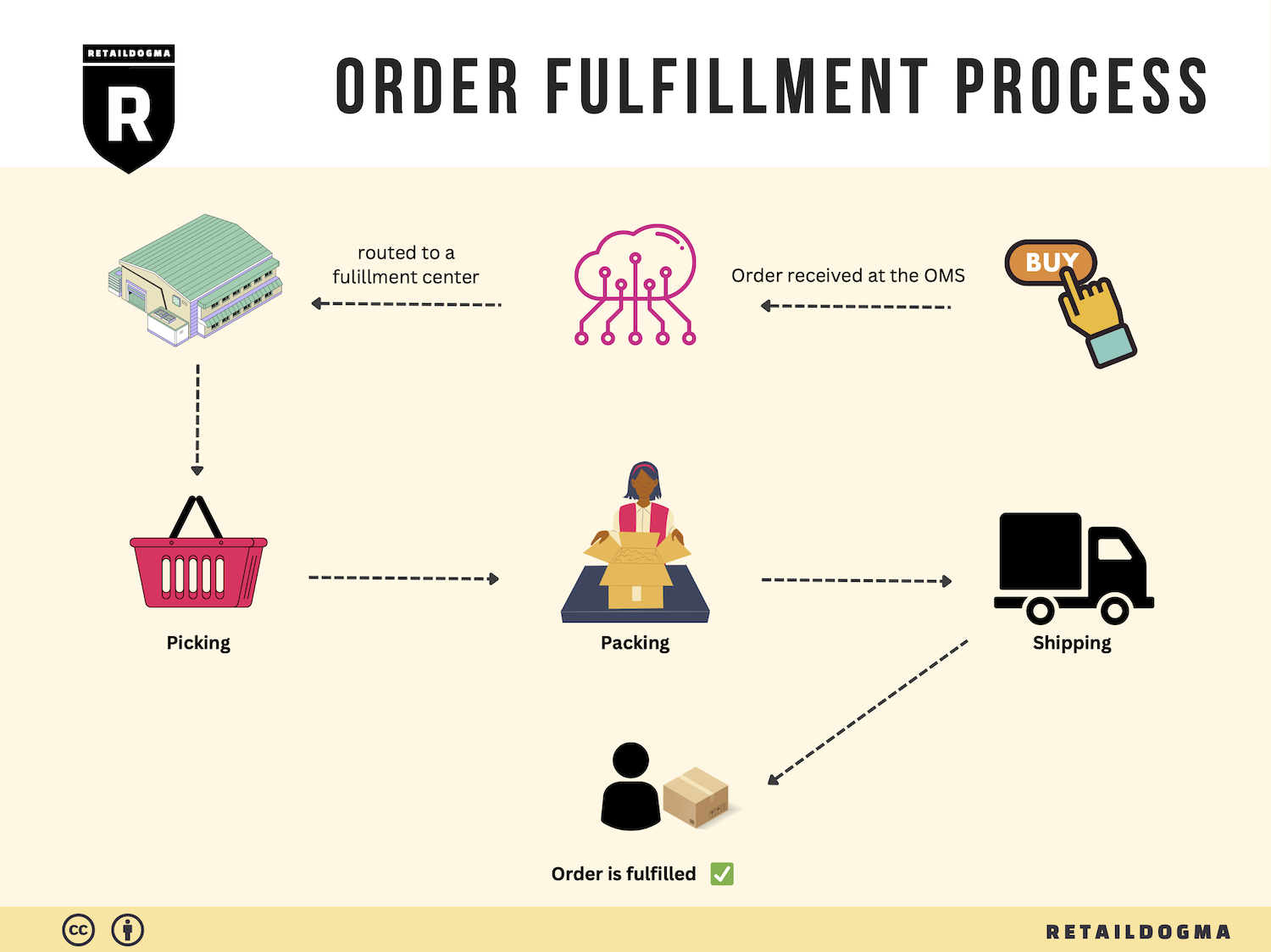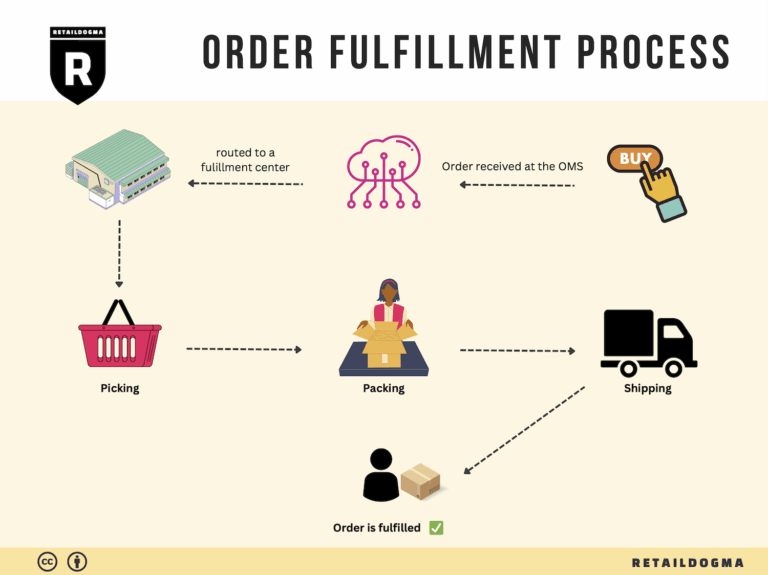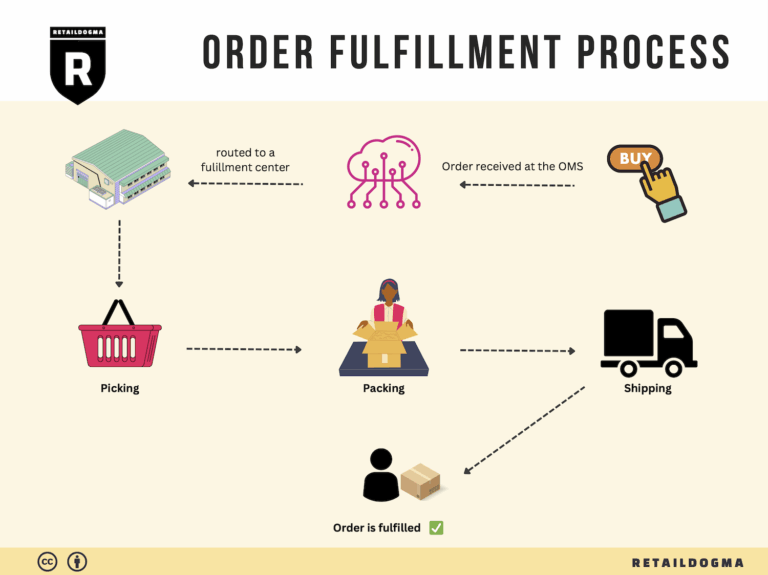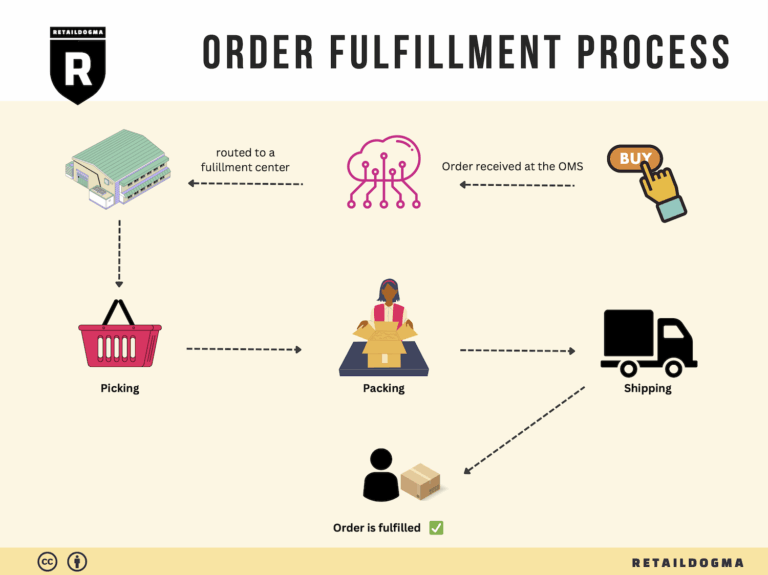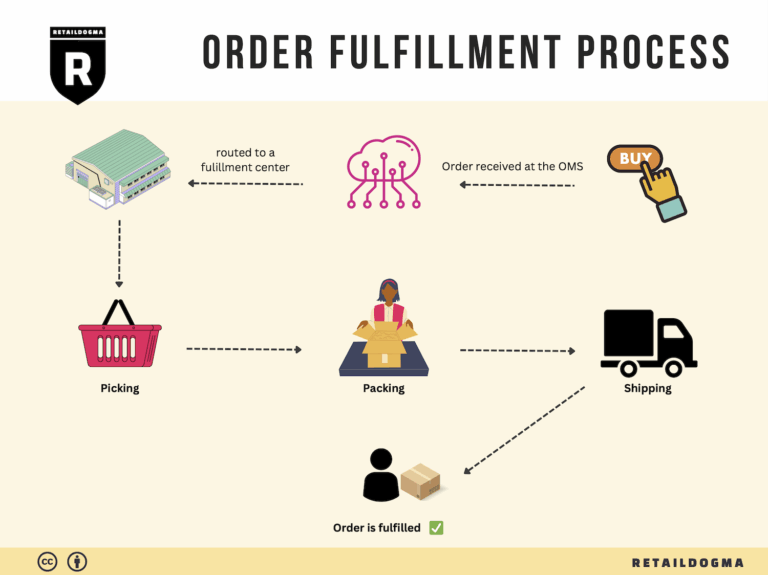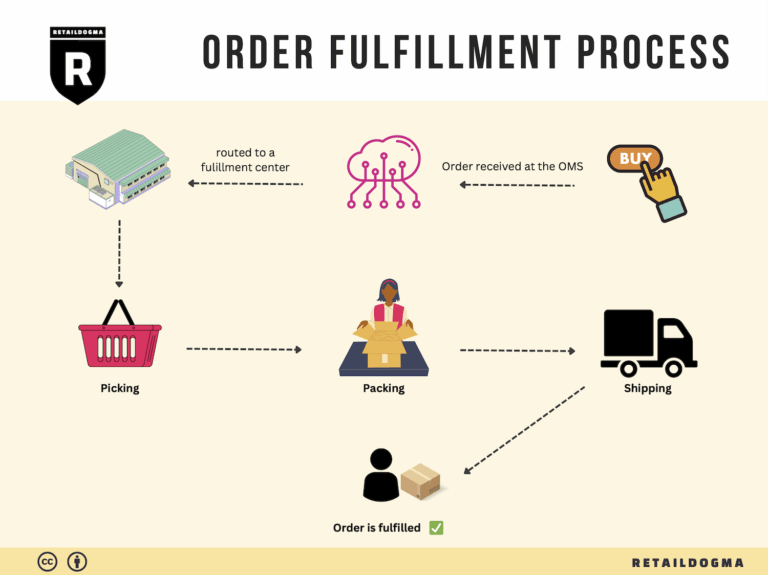Ecommerce Fulfillment Services: The Ultimate Guide (2025)
What is E-commerce Fulfillment? An Introduction for Growing Businesses
As e-commerce businesses expand, many owners and operations managers face a common challenge: the overwhelming task of packing and shipping orders. The excitement of increased sales can quickly turn into stress when the logistics of fulfillment become unmanageable. From ensuring timely deliveries to maintaining inventory accuracy, the complexities of getting products into customers’ hands can be daunting. Understanding and optimizing the fulfillment process is crucial for scaling operations efficiently and effectively.
Understanding E-commerce Fulfillment
At its core, e-commerce fulfillment is the process of getting a product from the warehouse to the customer’s doorstep. This encompasses everything from inventory management and order processing to packing, shipping, and handling returns. A well-structured fulfillment strategy not only enhances customer satisfaction but also allows businesses to focus on growth and innovation rather than being bogged down by logistics.
What This Guide Covers
In this guide, we will explore various fulfillment models that can help streamline your operations. You will learn about Third-Party Logistics (3PL) and Fulfillment by Amazon (FBA), among other options, to determine which best fits your business needs. Each model has distinct advantages and considerations, making it essential to evaluate your specific requirements.
We will also delve into the core services involved in fulfillment. Understanding these services—such as inventory storage, order picking, packing, shipping, and returns management—will empower you to make informed decisions about your logistics strategy.
Choosing the Right Fulfillment Partner
Selecting the right fulfillment partner is a critical step in scaling your e-commerce operations. We will provide insights on what to look for in a logistics partner, including reliability, technology integration, and customer service capabilities. A good partner can significantly impact your efficiency and customer satisfaction.
Understanding Pricing Structures
Finally, we will break down the pricing structures typically associated with fulfillment services. Understanding the costs involved will help you budget effectively and identify opportunities for cost savings without sacrificing service quality.
Empowering Your Business
The goal of this guide is to equip you with the knowledge and tools necessary to make smart, strategic decisions about your e-commerce fulfillment process. By mastering the logistics of getting products to your customers, you can not only alleviate operational pressures but also position your business for sustainable growth in a competitive marketplace. Whether you are just starting or looking to optimize an existing operation, this guide will serve as your roadmap to successful e-commerce fulfillment.
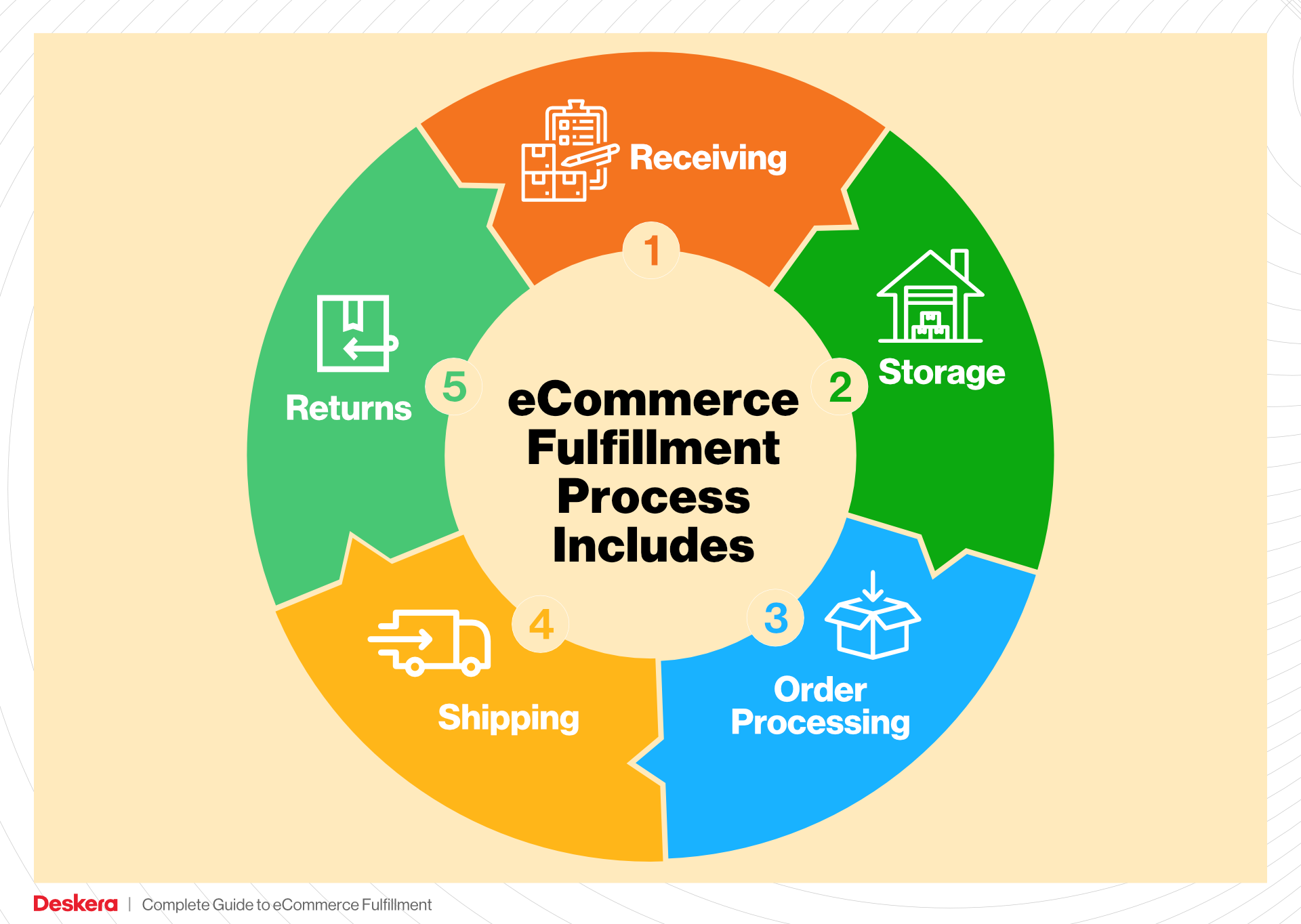
What You’ll Learn In This Guide
- What is E-commerce Fulfillment? An Introduction for Growing Businesses
- The Order Fulfillment Process: From ‘Buy’ Button to Customer’s Door
- Comparing Fulfillment Models: In-House vs. 3PL vs. Dropshipping
- A Deep Dive into Amazon FBA: Pros, Cons, and Who It’s For
- Core Services Offered by Fulfillment Centers
- How to Choose a Fulfillment Partner: A 6-Point Checklist
- Understanding Fulfillment Pricing: A Breakdown of Common Fees
- Frequently Asked Questions (FAQs) about Fulfillment
- Conclusion: Is Outsourcing Fulfillment the Right Move for Your Business?
- Important Disclaimer
The Order Fulfillment Process: From ‘Buy’ Button to Customer’s Door
1. Receiving Inventory
The order fulfillment process begins with receiving inventory, a crucial step that lays the groundwork for efficient operations. During this phase, products are delivered to the fulfillment center, where they are checked against purchase orders to ensure accuracy. Each item is assigned a Stock Keeping Unit (SKU), a unique identifier that facilitates inventory management.
Why is this important? Accurate receiving helps prevent stock discrepancies, which can lead to fulfillment delays and customer dissatisfaction. Inaccurate inventory data can have cascading effects throughout the supply chain, leading to overstocking or stockouts. Moreover, a well-organized receiving process establishes a solid foundation for subsequent steps, enabling smooth operations in the warehouse.
2. Warehouse Storage
Once inventory is received and verified, the next step is warehouse storage. Efficient storage involves categorizing and placing products in designated areas of the fulfillment center. This process often utilizes a systematic approach, such as zone picking or random storage, to optimize space and improve accessibility.
Why is this important? Effective warehouse storage minimizes retrieval time during order picking, which directly impacts order fulfillment speed. A well-organized warehouse can significantly enhance operational efficiency, reduce labor costs, and improve order accuracy. Key terms associated with this step include “bin locations” and “inventory management systems,” which help track the placement and availability of products.
3. Order Picking
Order picking is the process of selecting items from the warehouse to fulfill customer orders. This step can involve various methods, such as single order picking, batch picking, or wave picking, depending on the volume of orders and the layout of the warehouse. Pick lists, which detail the items and quantities needed for each order, are generated to guide pickers in their tasks.
Why is this important? The picking process is critical because it directly influences the speed and accuracy of order fulfillment. Efficient picking methods can reduce labor costs and enhance overall productivity. Furthermore, minimizing picking errors is essential for maintaining customer satisfaction and loyalty. Utilizing technologies like barcode scanners or RFID systems can streamline this process and increase accuracy.
4. Order Packing
After items have been picked, they move on to the order packing stage. During this phase, products are carefully packaged to ensure they arrive at the customer’s location in perfect condition. Proper packing involves choosing the right materials, such as boxes, bubble wrap, or packing peanuts, and including necessary documentation like packing slips and return instructions.
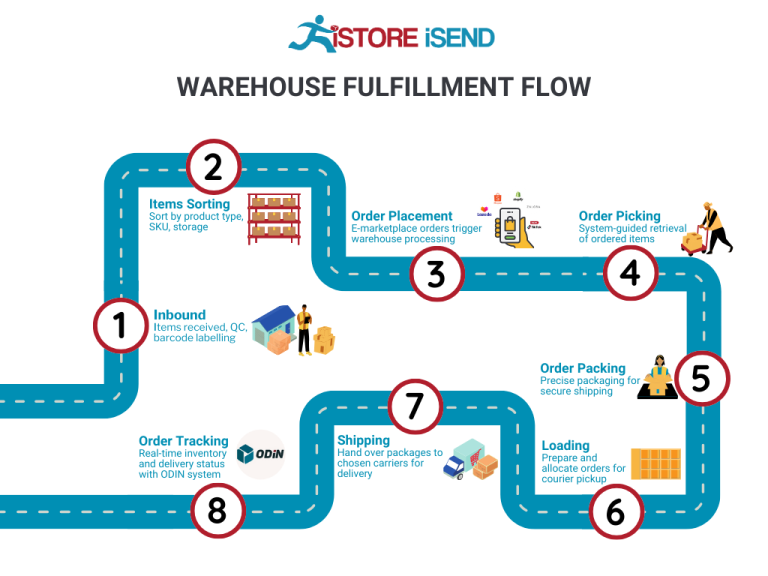
Why is this important? Effective packing not only protects items during transit but also enhances the overall customer experience. A well-packed order can reduce return rates due to damage, thereby saving costs and improving profitability. Additionally, utilizing eco-friendly packing materials can bolster a brand’s reputation and appeal to environmentally conscious consumers. Key terms to consider here include “dimensional weight pricing” and “packaging optimization.”
5. Shipping & Delivery
The final step in the order fulfillment process is shipping and delivery. Once orders are packed, they are labeled and prepared for shipment through selected carriers. Timely shipping is crucial for meeting customer expectations, as consumers increasingly demand faster delivery options. Fulfillment centers often utilize shipping software to compare rates and services from various carriers, ensuring cost-effective and reliable delivery.
Why is this important? The shipping and delivery stage is the last touchpoint in the customer journey and can significantly influence overall satisfaction. Delays or issues during this phase can lead to negative reviews and loss of repeat business. Therefore, maintaining strong relationships with carriers and utilizing tracking systems can help ensure a seamless delivery experience. Key terms to understand in this context include “last-mile delivery” and “shipping logistics.”
By understanding and optimizing each of these five steps—receiving inventory, warehouse storage, order picking, order packing, and shipping & delivery—e-commerce businesses can enhance their fulfillment processes, leading to increased efficiency, reduced costs, and improved customer satisfaction. Each component plays a vital role in the overarching order fulfillment strategy, ultimately driving business growth and scalability.
Comparing Fulfillment Models: In-House vs. 3PL vs. Dropshipping
Fulfillment Models Overview
When scaling an e-commerce business, choosing the right fulfillment model is crucial. Each model comes with its own set of advantages and disadvantages that can significantly impact operations, customer satisfaction, and overall profitability. Below is a comparison of three popular fulfillment models: In-House Fulfillment, Third-Party Logistics (3PL), and Dropshipping.
| Model | Who Handles Inventory | Best For (Business Stage) | Key Advantage | Key Disadvantage |
|---|---|---|---|---|
| In-House Fulfillment | Business itself | Established businesses with steady sales | Greater control over inventory and quality | Higher overhead costs and complexity |
| Third-Party Logistics (3PL) | Third-party provider | Growing businesses needing scalability | Reduced operational burden and flexibility | Less control over inventory management |
| Dropshipping | Supplier | Startups or businesses testing markets | Low upfront investment and risk | Lower profit margins and potential quality issues |
In-House Fulfillment
In-house fulfillment involves managing all aspects of inventory and order processing within the company itself. This model is best suited for established businesses that have a steady flow of sales and can justify the investment in warehousing, staff, and logistics systems.
Key Advantages: One of the primary benefits of in-house fulfillment is the level of control it offers. Businesses can directly oversee inventory management, quality control, and shipping processes, ensuring that products meet their standards and are delivered to customers promptly. This control can enhance customer satisfaction and brand loyalty, as companies can tailor their fulfillment processes to align with their unique value propositions.
Key Disadvantages: However, in-house fulfillment also comes with significant drawbacks. It requires substantial upfront investment in infrastructure, including warehouse space, technology, and personnel. Additionally, the complexity of managing logistics can strain resources, particularly as a business scales. Companies must also be prepared to handle fluctuations in demand, which can lead to excess inventory or stockouts.
Third-Party Logistics (3PL)
Third-party logistics (3PL) providers manage the storage, shipping, and handling of inventory on behalf of businesses. This model is particularly advantageous for growing businesses that need to scale operations without the burden of managing logistics internally.
Key Advantages: The primary advantage of using a 3PL is the ability to focus on core business activities while outsourcing logistics to experts. 3PL providers typically have established networks and systems that can improve shipping speed and reduce costs. This model offers flexibility, allowing businesses to scale operations up or down based on demand without incurring the high fixed costs associated with in-house fulfillment.
Key Disadvantages: On the downside, businesses relinquish some control over their inventory and fulfillment processes. This can lead to challenges in maintaining consistent quality and service levels, which are critical for customer satisfaction. Additionally, 3PL relationships can involve complex contracts and service level agreements, which may require careful management to ensure expectations are met.
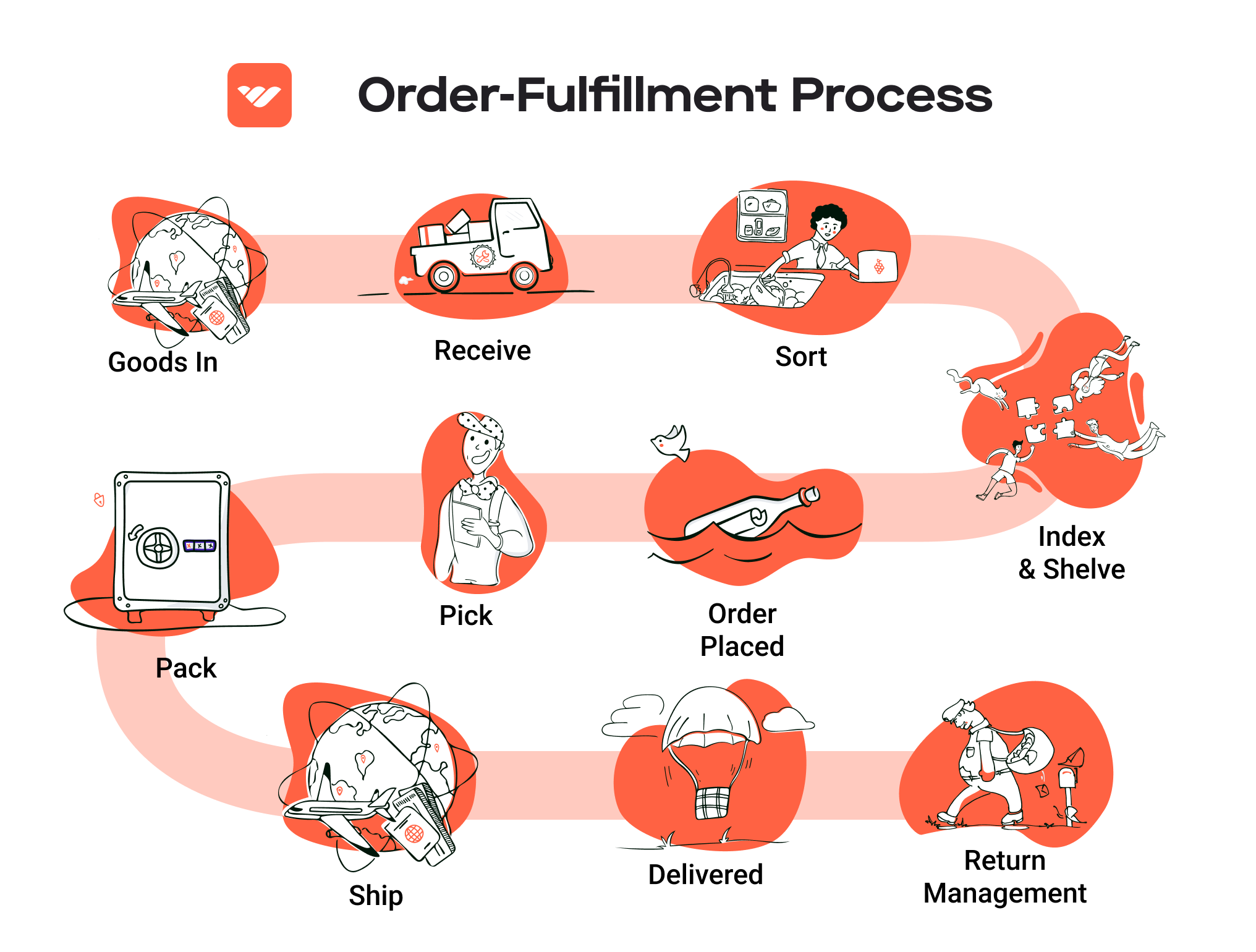
Dropshipping
Dropshipping is a fulfillment model where the retailer sells products without holding inventory. Instead, when a customer makes a purchase, the retailer forwards the order to a supplier who ships the product directly to the customer. This model is ideal for startups or businesses testing new markets.
Key Advantages: The most significant advantage of dropshipping is the low barrier to entry. Retailers do not need to invest in inventory upfront, allowing them to offer a wide range of products without the financial risk associated with unsold stock. This model enables businesses to experiment with different products and niches, making it a flexible option for entrepreneurs.
Key Disadvantages: However, dropshipping also presents challenges. Profit margins tend to be lower compared to other fulfillment models, as retailers must pay suppliers for each order without the benefit of bulk pricing. Additionally, reliance on suppliers for inventory and shipping can lead to quality control issues and longer shipping times, which may frustrate customers and damage the brand’s reputation.
Conclusion
Choosing the right fulfillment model is a critical decision for e-commerce business owners. Each model—In-House Fulfillment, 3PL, and Dropshipping—offers distinct advantages and disadvantages that can influence operational efficiency, customer satisfaction, and overall business success. By carefully evaluating the specific needs, stage of growth, and financial resources of the business, owners can select the most suitable fulfillment strategy to support their scaling ambitions.
A Deep Dive into Amazon FBA: Pros, Cons, and Who It’s For
Understanding Fulfillment by Amazon (FBA)
Fulfillment by Amazon (FBA) is a service provided by Amazon that allows sellers to store their products in Amazon’s fulfillment centers. Amazon then takes care of storage, packaging, shipping, and customer service for these products. This means that when a customer orders a product, Amazon handles the entire fulfillment process, allowing sellers to focus on other aspects of their business.
How FBA Works
-
Setting Up Your Account: Sellers first need to create an Amazon seller account and enroll in the FBA program. This involves providing information about the business and agreeing to Amazon’s terms and conditions.
-
Listing Products: Once enrolled, sellers can list their products on Amazon. They must indicate which products will be fulfilled by Amazon.
-
Shipping Inventory: Sellers prepare their products according to Amazon’s guidelines and ship them to Amazon’s fulfillment centers. Amazon provides shipping labels and guidelines to streamline this process.
-
Storage and Management: Once received, Amazon stores the products in their warehouses. Sellers can monitor their inventory levels through the seller dashboard.
-
Order Fulfillment: When a customer places an order, Amazon picks, packs, and ships the product directly to the customer. Amazon also handles returns and customer service inquiries related to these orders.
-
Payment: After the sale, Amazon deducts its fees and transfers the remaining funds to the seller’s account, typically every two weeks.
Pros of Using Amazon FBA
1. Prime Eligibility
Products fulfilled by Amazon are eligible for Amazon Prime, which can significantly increase visibility and sales. Prime members often prefer products with this badge due to the promise of fast and free shipping.
2. Customer Trust
Amazon is a trusted brand with a robust customer service reputation. When sellers use FBA, their products benefit from this trust, as customers are more likely to purchase from sellers who utilize Amazon’s fulfillment services.
3. Multi-Channel Fulfillment
FBA allows sellers to fulfill orders from multiple sales channels (like their own website or other marketplaces) using Amazon’s infrastructure. This can streamline operations and reduce the complexity of managing multiple fulfillment processes.
4. Scalability
FBA is designed to support growing businesses. As sales increase, sellers can scale their operations without needing to invest in additional warehouse space or staff, as Amazon handles fulfillment logistics.
5. Simplified Logistics
Amazon manages the entire logistics process, including storage, packing, and shipping, freeing up sellers to focus on marketing and product development.
Cons of Using Amazon FBA
1. High Fees
While FBA offers many benefits, it also comes with costs. Sellers must pay storage fees based on the space their products occupy in Amazon’s warehouses and fulfillment fees for each order processed. These fees can accumulate quickly, especially for slow-moving items.
2. Strict Inventory Rules
Amazon has stringent inventory management policies. Sellers must adhere to guidelines regarding inventory levels, product preparation, and packaging. Failure to comply can result in penalties or even account suspension.
3. Commingling Risks
FBA allows for commingling of inventory, meaning that products from different sellers may be stored together. While this can simplify logistics, it poses a risk if products are damaged or misattributed to the wrong seller, leading to potential quality control issues.
4. Loss of Control
Using FBA means relinquishing some control over the fulfillment process. Sellers must trust Amazon to handle their products and customer service, which can be a concern for those who prefer a hands-on approach.
5. Competition
With millions of sellers using FBA, competition can be fierce. Standing out in a crowded marketplace requires effective marketing and differentiation strategies.
Who is FBA Best For?
Fulfillment by Amazon is particularly beneficial for certain types of businesses:
-
Small to Medium-Sized Businesses: Companies looking to scale quickly without investing heavily in logistics and warehousing can find FBA a cost-effective solution.
-
E-commerce Startups: New businesses can leverage Amazon’s vast customer base and fulfillment network to gain traction without the upfront costs associated with establishing their own fulfillment infrastructure.
-
Sellers with High Sales Volume: Businesses that can maintain a consistent and high sales volume can better absorb FBA fees and take advantage of the service’s benefits.
-
Sellers of Unique or Niche Products: Brands that offer specialized products can use FBA to reach a broader audience while ensuring that they maintain quality and customer satisfaction.
In conclusion, Fulfillment by Amazon presents a powerful opportunity for e-commerce sellers to enhance their operational efficiency, access a vast customer base, and scale their businesses. However, it is essential to weigh the pros and cons carefully and assess whether FBA aligns with your business model and growth strategy.
Core Services Offered by Fulfillment Centers
Inventory Management & Warehousing
Inventory management and warehousing are foundational services provided by fulfillment centers. This involves the systematic tracking and storage of products to ensure that inventory levels are maintained according to demand. Fulfillment centers utilize sophisticated inventory management systems that allow businesses to monitor stock levels in real time, enabling them to avoid stockouts or overstock situations.
Benefits for E-commerce Businesses:
1. Efficient Stock Control: With advanced inventory management tools, businesses can better predict demand based on historical data and trends. This proactive approach minimizes excess inventory and reduces holding costs.
2. Space Optimization: Fulfillment centers are designed to maximize storage space. By outsourcing warehousing, e-commerce businesses can free up valuable retail space or office space, reducing overhead costs.
3. Accessibility and Scalability: As businesses grow, their inventory needs can change dramatically. Fulfillment centers provide flexible warehousing solutions that allow companies to scale their inventory storage up or down according to seasonal trends or market demands without the need for long-term commitments.
Pick and Pack Services
Pick and pack services refer to the process of collecting ordered items from storage (picking) and packaging them for shipment (packing). This process is critical in ensuring that orders are fulfilled accurately and efficiently.
Benefits for E-commerce Businesses:
1. Accuracy and Speed: Fulfillment centers employ trained staff and automated systems to ensure that orders are picked accurately. This reduces the chances of errors that can lead to customer dissatisfaction and returns.
2. Time Savings: By outsourcing this labor-intensive process, e-commerce businesses can focus on core activities such as marketing and product development. Fulfillment centers often have streamlined processes that allow for faster turnaround times, enhancing customer satisfaction.
3. Cost Efficiency: The economies of scale achieved by fulfillment centers can lead to reduced shipping costs. They often have negotiated rates with carriers, allowing e-commerce businesses to benefit from lower shipping expenses.
Kitting and Assembly
Kitting and assembly involve combining multiple products into a single ready-to-sell unit. This may include bundling items together for promotional sales or assembling products that require some level of configuration before they can be shipped.
Benefits for E-commerce Businesses:
1. Customization Options: Offering customized kits can attract more customers and differentiate a brand from competitors. Fulfillment centers can efficiently assemble these kits based on customer preferences or seasonal trends.
2. Streamlined Operations: By having kitting and assembly handled by the fulfillment center, businesses can reduce the complexity of their operations. This allows for a more focused approach to inventory management and order fulfillment.
3. Enhanced Customer Experience: Kitted products can improve the overall shopping experience by providing customers with complete solutions. This not only increases average order value but also encourages repeat purchases.
Returns Management (Reverse Logistics)
Returns management, or reverse logistics, is the process of handling product returns from customers. This includes receiving returned items, inspecting them, restocking them if possible, and managing the logistics of the return process.
Benefits for E-commerce Businesses:
1. Improved Customer Satisfaction: A well-managed returns process can significantly enhance customer trust and satisfaction. Fulfillment centers can facilitate easy returns, making the experience hassle-free for customers, which can lead to repeat business.
2. Cost Recovery: Efficient returns management allows businesses to recapture value from returned items. Fulfillment centers can assess the condition of returned goods and decide whether to restock, refurbish, or recycle, helping businesses recover some costs.
3. Data Insights: Analyzing return data can provide valuable insights into customer behavior and product performance. This information can help e-commerce businesses identify trends, improve product offerings, and refine marketing strategies.
Conclusion
The core services offered by fulfillment centers—inventory management and warehousing, pick and pack services, kitting and assembly, and returns management—are essential for e-commerce businesses aiming to scale effectively. By leveraging these services, businesses can optimize their operations, enhance customer satisfaction, and ultimately drive growth. In an increasingly competitive marketplace, partnering with a fulfillment center can provide the logistical support needed to meet customer expectations and succeed in the e-commerce landscape.
How to Choose a Fulfillment Partner: A 6-Point Checklist
Location & Warehouse Network
The geographical location of your fulfillment partner’s warehouses is crucial for effective logistics. A partner with a strategically placed network of warehouses can significantly reduce shipping times and costs, enhancing customer satisfaction.
Key Questions to Ask:
– Where are your warehouses located, and how do they align with our target markets?
– What is your average shipping time to our primary customer locations?
– Do you have a plan for expanding your warehouse network in the future?
Technology & Integrations
In today’s digital landscape, technology plays a vital role in ensuring seamless operations. Your fulfillment partner should utilize advanced systems for inventory management, order processing, and tracking. Compatibility with your e-commerce platform is also essential for smooth data flow.
Key Questions to Ask:
– What technology do you use for inventory management and order fulfillment?
– Can your systems integrate with our existing e-commerce platforms and ERPs?
– How do you handle data security and privacy, especially regarding customer information?
Specializations (e.g., Cold Storage, Oversized Items)
Depending on the nature of your products, you may require specific handling capabilities. If you sell perishable goods, for example, a partner with cold storage facilities is necessary. Similarly, if your products are oversized or fragile, ensure the partner can accommodate those needs.
Key Questions to Ask:
– What specializations do you offer that align with our product types?
– How do you ensure the quality and safety of specialized items during storage and shipping?
– Can you provide examples of how you’ve handled similar products in the past?
Scalability & Capacity
As your business grows, your fulfillment needs will evolve. Your partner should be able to scale operations to accommodate increased order volumes without sacrificing service quality. Understanding their capacity limits and growth plans is essential for long-term partnership success.
Key Questions to Ask:
– What is your current capacity for order fulfillment, and how do you manage peaks in demand?
– How quickly can you scale operations if our order volume increases?
– Do you have contingency plans for unexpected surges in demand?
Pricing and Contracts
Cost is always a critical factor when selecting a fulfillment partner. However, it’s important to look beyond the base price and understand the complete pricing structure, including hidden fees. Contracts should be flexible enough to accommodate your business’s growth and changes.
Key Questions to Ask:
– Can you provide a detailed breakdown of your pricing structure, including any additional fees?
– What are the terms of the contract, and how flexible are they in terms of scaling or service changes?
– Are there penalties for early contract termination or changes in order volume?
Customer Support & Reviews
Effective customer support can make a significant difference in your fulfillment experience. Look for a partner with a strong track record of responsive and helpful customer service. Additionally, researching reviews and testimonials from other clients can provide insight into their reliability.
Key Questions to Ask:
– What customer support options do you offer (e.g., phone, email, chat)?
– How do you handle issues or disputes that arise during fulfillment?
– Can you provide references or case studies from current or past clients?
Conclusion
Choosing the right fulfillment partner is a critical decision that can impact your business’s efficiency and customer satisfaction. By thoroughly evaluating potential partners based on this checklist, you can ensure that your choice aligns with your operational needs and growth plans. Prioritize these factors to build a strong foundation for your logistics strategy and ultimately enhance your e-commerce success.
Understanding Fulfillment Pricing: A Breakdown of Common Fees
Initial Setup Fees
When partnering with a fulfillment center like Yami, businesses often encounter initial setup fees. These costs are typically associated with onboarding your account and integrating your inventory into their system. Initial setup fees may cover various tasks, including account creation, software integration, and training on how to use the fulfillment platform effectively.
The calculation of initial setup fees can vary significantly based on the complexity of your needs. For instance, if your business requires custom software integrations or specialized training for your team, expect higher setup fees. Conversely, a straightforward setup with minimal customization will likely incur lower costs. Businesses should inquire about the specific services included in the initial setup to avoid unexpected charges.
Receiving Fees
Receiving fees are charged when the fulfillment center receives your inventory. This fee often includes unloading, inspecting, and storing your products in the warehouse. The calculation for receiving fees can depend on several factors, such as the volume of inventory being received and the complexity of the items (e.g., oversized or fragile products).
Typically, receiving fees are calculated on a per-pallet or per-sku basis. For example, a fulfillment center may charge a flat rate for each pallet received, or a fee per SKU if you have a diverse inventory. To minimize these costs, businesses should consider consolidating shipments or negotiating bulk receiving rates with their fulfillment partner.
Storage Fees (per pallet/bin)
Storage fees are incurred for keeping your inventory in the fulfillment center’s warehouse. These fees can be charged on a monthly basis and are usually calculated on a per-pallet or per-bin basis, depending on the size of your inventory.
The calculation for storage fees often considers the total volume of your inventory and how long it remains in the warehouse. Many fulfillment centers have tiered pricing structures, where costs decrease with higher volumes. It’s crucial for businesses to monitor inventory turnover rates to avoid unnecessary storage fees, as long-term storage can significantly impact profitability.
Pick & Pack Fees (per item/order)
Pick and pack fees are charged for the labor involved in picking items from the warehouse shelves and packing them for shipment. This fee can be structured in various ways—some fulfillment centers charge a flat rate per order, while others may charge based on the number of items in the order.
For example, a fulfillment center might charge $1.50 per item picked and packed, or a flat fee of $3.00 for any order, regardless of the number of items. Understanding your order volume and average order size can help you estimate these costs more accurately. Businesses can also negotiate lower rates based on their order volume or frequency.
Shipping Fees
Shipping fees cover the cost of transporting your products to the customer. These fees can vary widely based on several factors, including the shipping carrier, shipping method (e.g., standard, expedited), and destination.
Shipping fees are typically calculated based on weight and dimensions of the package, as well as the distance it must travel. Fulfillment centers may have partnerships with various carriers, allowing businesses to benefit from discounted shipping rates. It is advisable to compare shipping options and negotiate rates with your fulfillment partner to ensure you are getting the best deal.
Tips for Getting an Accurate Quote
-
Provide Detailed Information: When seeking a quote, provide as much detail as possible about your business model, inventory size, and shipping volume. This helps fulfillment centers give you a more tailored estimate.
-
Ask About Hidden Fees: Inquire about any additional fees that may not be immediately apparent, such as returns processing or special handling fees.
-
Negotiate Rates: Don’t hesitate to negotiate pricing, especially if you have a higher volume of orders. Many fulfillment centers are open to adjusting fees based on expected business.
-
Request a Trial Period: If possible, request a trial period to assess the fulfillment service without committing to a long-term contract. This can help you evaluate costs and service levels.
-
Review Contracts Carefully: Before signing, thoroughly review the contract to understand all terms and conditions related to pricing. Look for clauses that may allow fees to increase over time.
By understanding these common fulfillment pricing models and following these tips, e-commerce business owners can make more informed decisions when selecting a fulfillment partner like Yami, ultimately leading to better cost management and improved operational efficiency.
Frequently Asked Questions (FAQs) about Fulfillment
1. What is Yami’s fulfillment center?
Yami’s fulfillment center is a state-of-the-art logistics facility dedicated to the storage, packing, and shipping of products specifically catering to the Asian American community. It operates an automated logistics system within a 450,000 square-foot warehouse, ensuring efficient order processing and quick delivery times.
2. How does Yami’s fulfillment process work?
Yami’s fulfillment process involves receiving inventory from suppliers, storing products in organized sections, and using automated systems to pick, pack, and ship orders. Once an order is placed online, the system identifies the product location, picks it, packs it securely, and ships it to the customer, often within one day.
3. What is the difference between a warehouse and a fulfillment center?
A warehouse is primarily focused on storing goods for extended periods, while a fulfillment center is designed for the rapid processing of orders and shipping directly to customers. Fulfillment centers often include additional services such as inventory management, order processing, and customer service, which are not typically provided by traditional warehouses.
4. What is a 3PL (Third-Party Logistics)?
A 3PL, or Third-Party Logistics provider, is a company that offers logistics services to businesses, including warehousing, fulfillment, and shipping. By partnering with a 3PL like Yami, e-commerce businesses can leverage their expertise and infrastructure to manage logistics efficiently without having to invest in their own facilities.
5. How much do fulfillment services cost at Yami?
The cost of fulfillment services at Yami varies based on factors such as order volume, storage needs, and additional services required. Typically, fulfillment costs can include storage fees, picking and packing fees, and shipping costs. Businesses are encouraged to contact Yami directly for a customized quote based on their specific needs.
6. What types of products can be fulfilled by Yami?
Yami specializes in fulfilling a wide range of products, particularly those favored by the Asian community. This includes snacks, beverages, beauty products, health supplements, kitchenware, and more. Their fulfillment center is equipped to handle diverse product categories while ensuring compliance with safety and quality standards.
7. How does Yami handle inventory management?
Yami employs an automated inventory management system that tracks stock levels in real-time. This helps ensure that products are always available for order fulfillment, reduces the risk of stockouts, and enables efficient reordering processes. Businesses can access their inventory data through Yami’s platform for better visibility and planning.
8. What shipping options are available through Yami’s fulfillment center?
Yami offers various shipping options to meet customer needs, including standard shipping, expedited services, and same-day delivery in select areas. The fulfillment center is designed to optimize shipping routes and costs, ensuring timely delivery to customers across North America.
9. How can businesses partner with Yami for fulfillment services?
Businesses interested in partnering with Yami for fulfillment services can reach out through their website or contact their sales team directly. Yami provides tailored solutions for different business models, whether you are a small startup or a larger enterprise looking to scale your logistics operations.
10. What are the benefits of using Yami’s fulfillment center for e-commerce?
Utilizing Yami’s fulfillment center provides several advantages, including fast processing times, access to a specialized logistics network, and the ability to focus on core business activities while Yami manages inventory and shipping. Additionally, Yami’s expertise in serving the Asian American community allows businesses to cater more effectively to this demographic.
Conclusion: Is Outsourcing Fulfillment the Right Move for Your Business?
Evaluating the Benefits of Outsourcing Fulfillment
In the fast-paced world of e-commerce, leveraging a fulfillment service can be a game-changer for businesses aiming to scale efficiently. By outsourcing fulfillment, you can save invaluable time and resources that can be redirected toward strategic growth initiatives. With a dedicated partner managing logistics, inventory, and shipping, your team can focus on core activities such as marketing, product development, and customer engagement.
Scalability is another significant advantage of utilizing a fulfillment service. As your business grows, so do the complexities of managing orders and inventory. A proficient fulfillment partner can seamlessly adapt to your evolving needs, whether you’re experiencing a seasonal surge or expanding your product line. This flexibility helps maintain customer satisfaction through timely deliveries and efficient service, which are critical for retaining loyal customers.
Moreover, partnering with experts in fulfillment means you gain access to specialized knowledge and technology that you may not possess in-house. This expertise can lead to improved operational efficiency, reduced shipping costs, and enhanced customer experiences. Well-established fulfillment centers often have automated systems and strategic partnerships that streamline processes, ensuring that your orders are fulfilled accurately and swiftly.
However, selecting the right fulfillment partner is crucial for sustainable growth. A misaligned partnership can lead to complications that hinder your business’s progress. Take the time to evaluate potential partners based on their capabilities, industry experience, and alignment with your business values.
Call to Action
To determine if outsourcing fulfillment is the right next step for your business, conduct a thorough audit of your current shipping processes. Identify bottlenecks, assess fulfillment costs, and evaluate customer feedback on delivery experiences. This analysis will provide clarity on whether a fulfillment partner could enhance your operational efficiency and support your growth objectives.
Important Disclaimer
⚠️ Important Disclaimer
The information in this guide is for educational purposes. Fulfillment services, pricing, and platform features change frequently. Always conduct your own due diligence and consult with providers directly before making business decisions.
